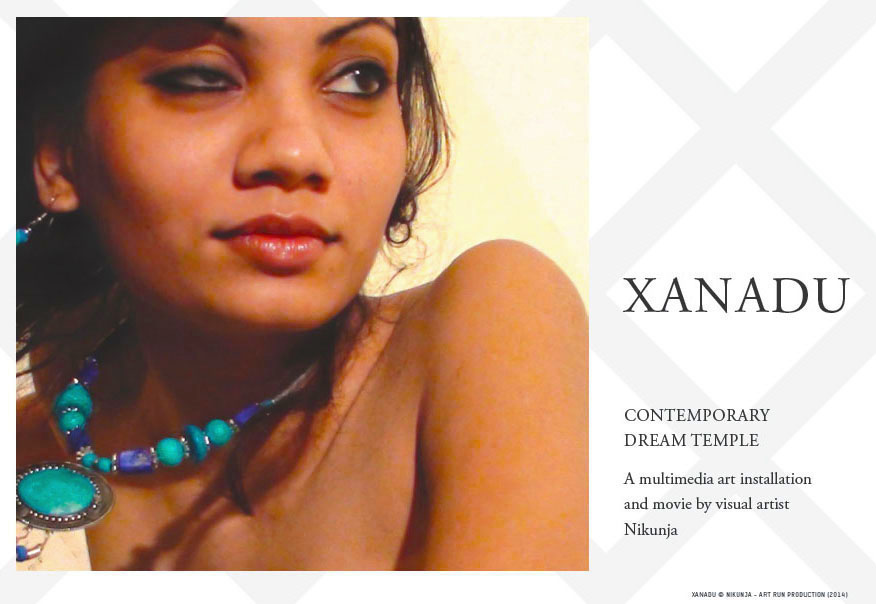
XANADU
Contemporary Dream Temple
A multimedia art installation and movie
“Dreams allow us to break with the patterns of day to day perception and convey a vaster reality of ourselves. The artificial separations in our mind disappear. Dreams connect us to the multi-layered reality of space and time. Dreams are reality. Right now: are you dreaming or are you awake? What we call awake could very well be asleep.” – Nikunja
Introduction
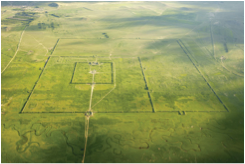
Ruins of Shangdu
Summer palace
of Kublai Khan
The dream as a creative energy
XANADU takes the ancient practice of the dream temples, present in many cultures since the dawn of man, into the contemporary artistic forms of an interdisciplinary and interactive, process orientated art installation and a feature movie. XANADU carries the dream as a creative energy, crossing time, place, media, age, and individual personalities.
Historical relation and cultural aspects
The title XANADU relates to the ancient summer palace of Chinese Emperor Kublai Khan in Shangdu. The palace was built in 1251, exactly according to the dream of the emperor. It is located in what is now called Inner Mongolia, 350 kilometres north of Beijing. Xanadu is seen as a reference to the universal encyclopaedia of human knowledge. The project title is born out of the context of Xanadu, Kublai Khan’s palace and Marco Polo (11th century), Samuel Taylor Coleridge’s poem (19th century), and Ted Nelson’s Internet concept for an encyclopaedia of humanity (20th century).
In many cultures dreams have had a special place in regards to the questioning of man regarding his existence and human condition, but also as a healing and spiritual practice or science. In Egyptian, Greek, Roman and Hebrew cultures, dream temples were created for people of important social status: kings, ministers and so forth. However, also the “average” man or woman would go to sleep and dream in a dream temple, and to receive advice by priests. Dreams were seen as a way to receive messages from deities and gods. Through the dreams they sought support for individual or social problems. The dreams were used to cure illnesses or to take important decisions. This practice was so significant, that in Greece alone, over 420 dream temples were established.
In our current times, dreams are key in psychoanalysis. Dreams may reveal knowledge a human being may have memorized in the unconscious part of his being. Beyond that, one may access a universal knowledge, the knowledge of humanity traveling through time and space.
XANADU is the contemporary artistic formulation of this cultural value of the dream world in regards to the individual quest for self-realization, beyond any religious attachment, philosophical interpretation, or scientific concept. It values the dream as a cultural and spiritual language, as an individual creative potential, which belongs to everyone, regardless of social status, race, religion, age or level of education.
By its artistic content, language, and form of creation, the artwork interrogates the intuitive, associative world of the dream, the creative potential of the dreamer, as well as the subjective division between the perception of reality and the various levels of dream perception.
Open-ended poetry
Nikunja will shoot the cinematographic work for XANADU entirely on Reunion Island. A post-colonial island society, suspended between African, Asian and European cultures, the world’s major religions, past and present, but also between historical crime and reconciliation. Reunion Island (the name signifies an act) is an exceptional place uniting extremes. Its landscape is very unstable, with a volcano in eruption, heat on sea level and snow on the Piton des Neiges at 3.000m altitude. Nikunja uses these aspects in his artwork as psychological references to social and individual states.
Nikunja creates intense movie images, close to paintings, composed through the unique light, colors and sounds of Reunion Island. The movies are based on an open narrative, which follow the main protagonist though a variety of mental states (based on real dreams). The landscapes create links towards vast experiences of consciousness. The images make connections between individual and universal memory and knowledge. The work evokes a dialogue between individual and universal perception, between the protagonist and the spectator.
Through its presence and the interaction with the artist in a creative process, the dream takes form in the physical reality through Nikunja’s artistic formulation. The process creates an open-ended poetry, similar as dreams, allowing new perspectives and unforeseen artistic formulation on an infinite timeline.
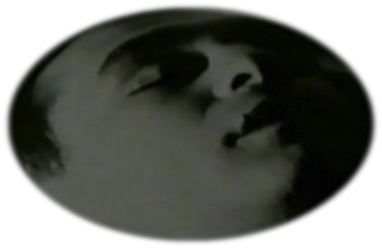
‘Sleeping Man’
by Man Ray
b/w 40' (1926)
Multimedia art installation: a space out of space
XANADU has an evolutive, interactive sculptural significance: the exhibition space, as a space out of space, as time out of time. Like the ancient dream temples, XANADU gathers the energies of the dreamt dreams, the energies and experiences of the visitors, specific to each place and time the installation is shown.
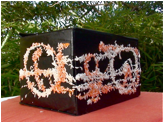
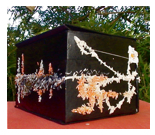
Exterior
The installation is set inside a mobile exhibition space of ± 600 cm high, 1.000 cm wide, and 1.200 cm long. In collaboration with Mauvilac ltd, Nikunja paints the exterior of the sculptural cube in glittering black (“email gloss black”). The outside carries drawings of cosmic constellations in raw seeds of rice. They link to the cosmic reality of “the space within space” and relate to the body as dream vessel. Birds are expected to pick the rice grains off the artwork, carrying the drawing into nature. Through this, the artwork interacts with its environment. The use of drawing also evokes “failed orientation”. In this context, failure is understood as a necessary human tool for progress. The drawing carries the same evolutive energy as the installation. The entrance door of 220 cm by 100 cm is installed at the right side of one of the small sides of the building. It opens to the outside and allows one spectator at a time to enter.
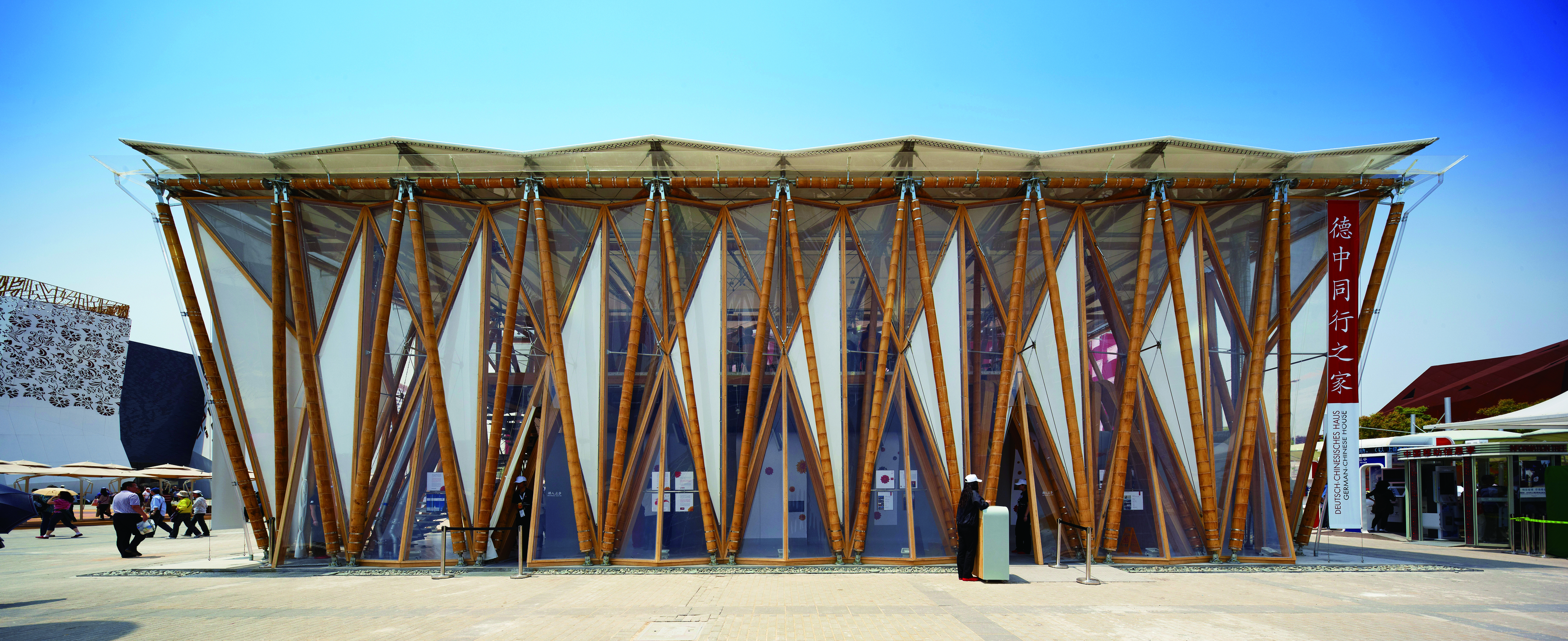
Bamboo House by Markus Heinsdorff
Renowned German installation artist Markus Heinsdorff designs a two-storey bamboo membrane structure. This innovative construction technique allows an optimal natural climate, whether exposed to cold or hot weather. The roof, façades, and indoor columns are designed in the style of traditional paper folding techniques (similar to bamboo fans and umbrellas). The technique allows a fast (de)construction phase (5 to 6 days) without the need for heavy tools. All materials are fully recyclable and easy to separate or repair.
Markus Heinsdorff describes his design as follows:
“The bamboo house especially designed for Nikunja’s XANADU is as a lightweight construction made of natural bamboo canes with a membrane covering on the inside. The bamboo membrane construction consists of three components:
- A circular facade of 6,5 meter height made of natural bamboo canes, which are screwed together with connectors (knots) and are braced with thin steel ropes.
- A post-free interior with a membrane roof and white membrane walls, which at the same time serve as screens for film projections and installations of XANADU.
- A floor slab with a steel frame, which balances out all unevenness of the underground and at the same time serves as a mobile foundation. The slab is fixed either with earth anchors (steel nails) or non-visual concrete slabs as weight, depending on the consistency of the soil.
The area in the interior is 10 x 12 meters with entrances and exits on the side, the ceiling height is 6 meters. The walls and the ceiling are daylight proof.
The building is mobile applicable, light and high-strength. In addition, all components are fissile elements and are simply screwed together for the construction. Because of the light materials the building can be put up and assembled on sight without a crane.
In case of damage, each element can be replaced lasting and eco-friendly. All materials can be simply separated from each other and recycled or, after the end of the planned country tour, be put up as a permanent building.”
This construction corresponds with the “enfoldment” of dreams. The design refers to Kublai Khan’s “moving palace” in bamboo, as described by Marco Polo. The bamboo material also referrers to energetic, unstoppable fast progression and transgression of ‘Tropicana’.
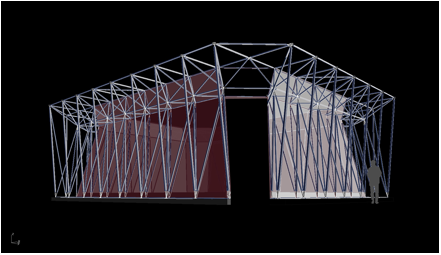
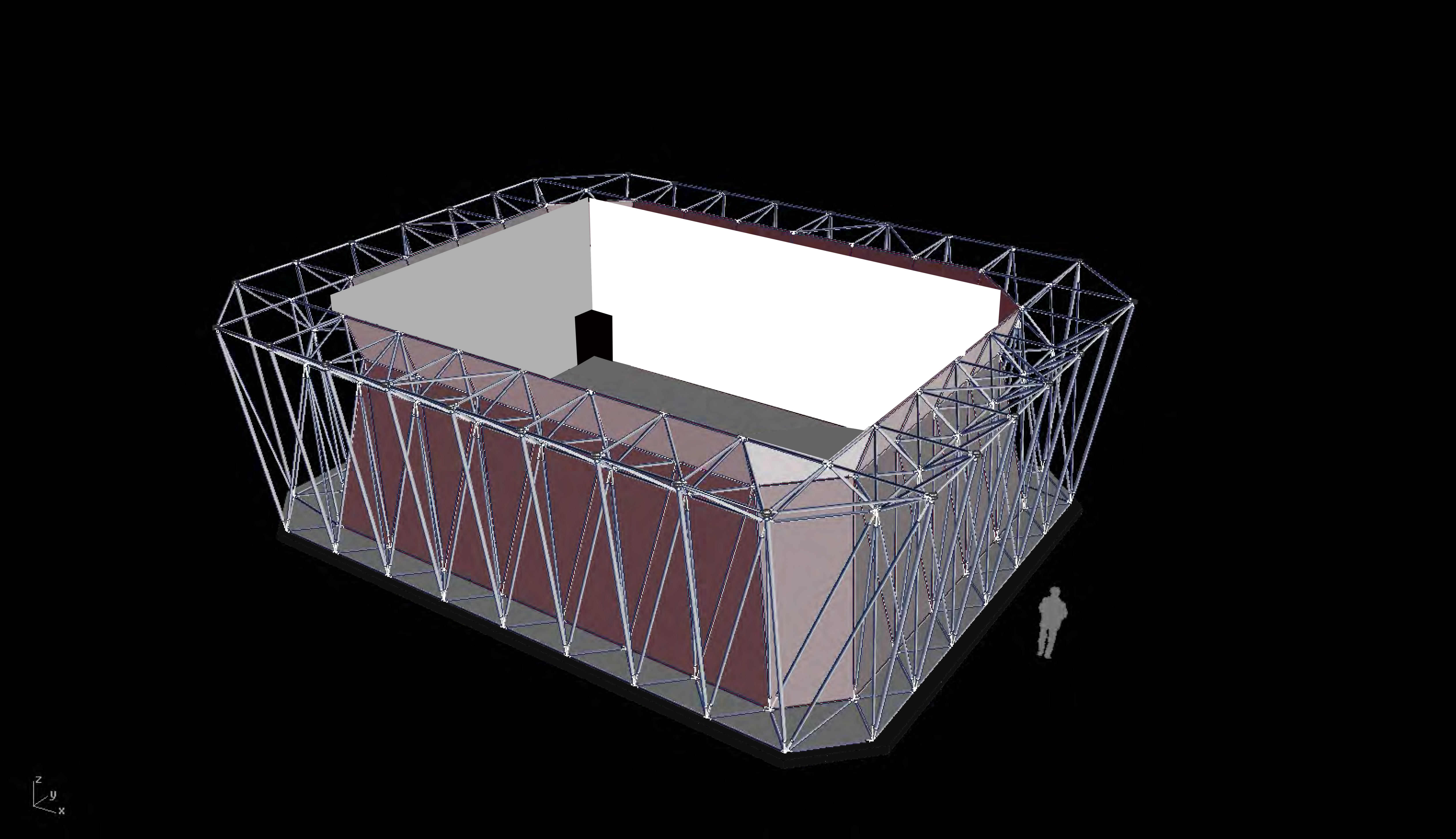
Concept for the bamboo structure
for XANADU
by Markus Heinsdorff
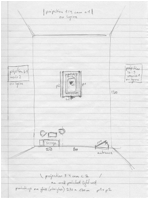
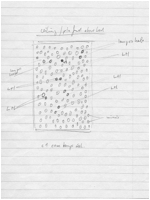
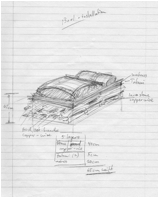
Interior
Bed installation
The centre of the room is dominated by a bed installation (± 60 cm high, 160 cm wide, and 200 cm long,). It is made out of copper plates and wires, lava stone, branches of birch trees and other elements. It is surrounded by a canopy bed construction made out of bamboo, holding a ceiling with small led lamps and mirrors, two paintings on glass and fine mousseline curtains. Tatamis hold the mattress, which is covered with a regular bedspread of a light blue colour.
A fine bamboo construction (± 300 cm high, 270 cm wide, and 300 cm long,) forms a palanquin around the bed-installation. Thin white mousselin fabrics are suspended. During daytime they are opened.
Two large-scale paintings (270 cm x 220 cm), oil on glass (Plexiglas) are suspended on the two long sides of the bed object, in a distance, leaving enough space for passage. Their faces are turned towards the bed object.
The bamboo construction holds a platform, also built from bamboo. It is painted black, which on top creates space for the technical equipment (projectors, cameras, computer). The downside facing the bed is covered with a light blue silky fabric and many small round mirrors and small round halogen lamps connected to a dimmer, to be regulated from the bed. A camera is installed into the platform, which transmits real time images from the bed view.
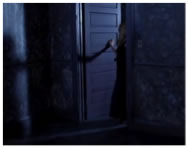
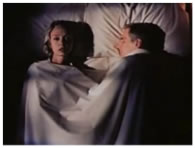
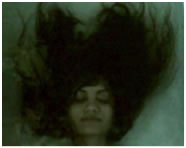

Video projections/screens and installation movies
Realised in cooperation with Sony Europe and videocation, GmbH
The installation holds a 4 channel video projection on all four walls and a sound distribution in an 8 channel Dolby surround sound through 32 high-quality Anthony Gallo loudspeakers and audio interface. The video projections are the only light source in the space, except for the bed installation overhead lights and a small reading lamp in the lounge installation.
The three walls opposing the entrance door are totally covered by large-scale lycra screens. The wall, through which the visitors enter, is painted light red.
The two projections on the two long walls are pre-produced high quality 4K HD video in 16:9 ratio format of about 70 minutes of length each, running in loops.
The two projections on the 2 small walls are real-time 2K HD projections in 4:3 format, of one transmits images of the visitor, entering the space (door). The other transmits images from an overhead camera, installed above the bed installation in the center of the space (bed). Both real-time projections are corrupted in irregular intervals by images of 1/3 to 1/2 seconds, directed by a quartz directed computer and barely noticeable. The door projection includes corruptions by images, registered 3, 5, 7 minutes prior to the corruption. The bed projection uses images registered during the night of the bed situation, introduced in the program in the morning.
The camera above the bed installation frames the head of the bed and shows the empty bed during daytime. At night the head of the dreamer is shown from an angle of ± 60 degrees. This framing may change according to the personality and the number of dreamers present.
The camera frames the entrance from the bed platform and the door in the centre. In this way, the real-time projection shows the door in the middle of the wall with a slight enlargement to about 300 cm height of the body representation of the visitor, creating awareness of the body size of the spectators present.
The two looped movies directed by Nikunja are in constant dialogue which each other and are made for the interior installation space. Considering the 4K projections are the only major light sources, modulating colour and rhythmic of dark and light, it is crucial to take into account the proximity of the spectator to the screen.
Although the movies do not follow a certain narration on a limited timeline, the spectator has the sensation of advancement. The films referrers to the extreme landscapes of Reunion Island and to mental spaces of the protagonist and the spectator. The camera views are crossing primary forests, lava fields, craters and ravines, and also cityscapes, travelling across the island from the sea in the east to the ocean in the West. This travel crosses time, age, day and night, weather conditions, and existential elements.
French cinematographer Jean Marc Selva captures images of the extreme Reunion Island landscapes between volcano and ocean. We see intimate images of the main protagonist, but also video sampling and reframes of different movies and found footage. These are used in the quest to touch levels of the human dreaming reality, from individual to collective memory, from contemporary to age-old knowledge. The compositions use a language of associative intuition, as do the art performances staged in these landscapes.
Nikunja creates the performances in collaboration with Mauritian actress and artist Mannee Jeeanah. They are developed from real dream experiences of the main protagonist, collected over a period of 4 years. The performances are not literal representations of those dreams, but take their energy as a base for the artistic formulation of universal relevance.
The slow images inspire the spectator to open his own intuitive creative potential. Through his specific editing formulations through superpositions, reframing, modulations of colour and resolution, Nikunja treats the cinematographic images materiality as a mental plane, directly involving the perception of the spectator in his own unique way.
Soundtrack
Both movies are accompanied by the same soundtrack,audible throughout the whole art installation. It is formed through an 8 channel sound composition created by Nikunja in collaboration with Swiss electronic musician Alain Perret and French sound engineer Benoit Ouvrard. It includes individual electronic tones, evoking physical sensations with deep base frequencies and supersonic frequencies next to various sounds like of the Indian dilruba, flutes, voices, sampling, natural sounds, et cetera. The composition conveys a specific experience according to the position of the visitor in the installation space and his movements. The volume level in general is not very high. It is more like a background sound with some significant peaks. The 32 Anthony Gallo high-quality loud speakers installed behind the screen on various heights in the space allow a subtle modulation of the sounds.
The soundtrack has an additional important significance. It functions as an invisible, immaterial energy with a great impact on emotion, body and spirit. It gives access to a non-analytical and intuitive perception, similar to a dream. The soundtrack furthermore connects the various visual and material parts of the installation to the visitors.
Lounge installation
Alongside the wall, towards the corner to the left, passing the entrance door, couches and a lounge table with a small lounge lamp, regulated by a dimmer is arranged. Here the visitors may create notes, commentaries, drawings or other manifestations of expression on prepared papers and white carbon pieces or just take time, contemplate on the images or sounds. The visitor may place his expressions onto the projection screens of the art installation. A digital photo camera linked to a small printer also allows the visitors to take and print small format photographs, which can also be left behind in the space. Thus the installation may change its appearance through each visitor and at each moment in a form of open poetry from exhibition to exhibition. The interventions by the visitors are an integral part of XANADU. On the lounge table the visitor can find a large glass bowl. Here the visitor can leave his/her name and contact information for the lottery, to be chosen to participate in the Dream Nights.
The Dream Nights
Chosen visitors (by lottery) or invited protagonists (personalities, actors and artists) are invited to spend the entire night alone, or accompanied by one other person of their choice, sleeping and dreaming in the bed installation, similar to ancient times as the seekers of truth on the bed shrines of the dream temples. They can also leave notes, comments, drawings, and photos about their dreams or experience on the large-scale paintings.
A personal service for the basic personal needs of the dreamer can be called through an intercom. The protagonists are accompanied to a destination of their choice. Through the energy of the dreamt dreams, the installation generates a growing energy: a space between the dream world and the physical realm. This may have an affect on the dreams the participants have and the perceptions the visitors may discover.
In the morning, Nikunja meets them for a breakfast and short interview to reflect on the experience and the dreams. This is recorded on video.
When the dream (experience) is significant, it is transformed into a performance, if necessary with actors, costumes, et cetera. This turns the dream into a physical as well as a further artistic form. This performance and the artistic process are filmed.
The spectator as performer
When entering the installation space of XANADU, the visitor (consciously or unconsciously) enters a stage. The visitor becomes a “performer”, a body outside of the body. The visitor is present in and part of the artwork.
The spectator has an impact on the artwork and can be aware, that his/her “performative behaviour” determines the perception of the artwork. What does the spectator give attention to and for how long?
How does he/she move through the space? The spectator can create his/her own scenario, through his/her own filtering or editing process while interacting with the installation.
The distance the spectator has towards the projected cinematographic images, determines what he/she can perceive of the representations. In a continuous flow of the merging media, the spectator becomes the creative force, allowing unlimited mental explorations of his/her existential consciousness. The experience of the installation is individual, open and free. It allows an unlimited personal experience, a travel through the intuitive and associative world of the spectator.
For the selected dreamers in the Dream Nights, the experience may continue into an artistic experience with the presence of the artist and an even deeper personal travel, transgressing the imaginary distinction between dream world and physical world.
XANADU - FEATURE LENGTH MOVIE
The multimedia art-installation XANADU is an open-ended artwork in progress, preceding and leading to the creation of a feature length movie.
After an exhibition period of about 2 years in various countries, Nikunja will select from the gathered material and edit a feature length movie (expected completion 2018). This new artistic work is based on the experiences, evolutions, performances and footage collected from the various exhibition places in many different parts of the world. It will connect people from different cultures and origins, social backgrounds and life-experiences.
Emphasis is given to aspects like the landscape, the weather conditions, the language of gestures, intuitive dialogues, and the creation of subjective cinematography.
The movie gets its true form in the final editing process, where the individual stories meet and cross each other. This will create a new dramaturgy and meaning beyond the individual event of performance.
Another crucial element, are images of the sleeping participants, which will contribute to the rhythm of the movie.
Financial partners
The realisation of the art installation, which is produced by Artrun Production, Reunion Island in partnership with FRAC (Fonds Regional Art Contemporain) and L'Artothèque de Saint-Denis (Reunion Island), is supported by cultural institutions of Reunion Island, a French department in the Indian Ocean (Conseil Régional Réunion, Conseil Général) of France and Switzerland, as well as of the Cities of Saint Paul, Saint Denis (capital Reunion Island) and art institutions on the community level. Several private sponsors grant substantial material and financial support. At each exhibition place we will collaborate with local cultural institutions and sponsors.
Worldwide distribution
Commissioner and organiser Dream Amsterdam Foundation and curator Jamain Brigitha have submitted an application for the exhibition of XANADU within the frame of the upcoming Collateral Events of La Biennale di Venezia 56th International Art Exhibition. The Venice Biennale is the world’s oldest and most important international exhibition of contemporary art, following the most recent developments of international art research. If selected, XANADU premiers in Venice from May to November 2015.
After this first exhibition period, XANADU will be exhibited on Reunion Island in the Cities of Saint Paul, Saint Denis (capital) and other regional cities at the end of 2015, beginning of 2016. XANADU is in option for an exhibition in Cannes during the Cannes International Film Festival 2016 and the City of Wroclaw, European Cultural Capital 2016.
Artrun Production and Nikunja established a close cooperation with before mentioned internationally renowned curator Jamain Brigitha and Dream Amsterdam Foundation, whom accompany and support the international exhibitions of XANADU. Through Nikunja’s presentation of XANADU to selected members of CICAE (International Federation of Arthouse Cinemas and Arthouse Festivals) during the CICAE workshop a wide network of collaborations for future exhibitions is established. The workshops were supported by and accredited to the Venice International Film Festival 2014.
Between 2015 and 2017 other exhibitions are prepared in Spain, United States (collaboration with Sundance Festival), Uruguay (National Film Archive), Malta (in the Neolithic temples), the Netherlands (International Film Festival Rotterdam, TENT), Germany, and Denmark. In Paris, the project is supported for exhibitions in France by producer François Vila, former director of the Pavilion of the Cinema of the World at the Cannes International Film Festival.
We strive to exhibit the project at other key art venues, for instance international art fairs like Art Basel and Art Cologne (at both fairs, Nikunja had independent installation projects in 1983 and 1995), Armory Show, New York, international film festivals, like Cannes (Nikunja’s films were shown at the Pavillon du Cinema du Monde in 2007 and 2008), Locarno, Berlin, Durban (participated in 2007), New York FF, as well as art Biennales and art institutions, e.g. Haus der Kulturen der Welt Berlin, Tate London, Dia Foundation,
New York, Queens Museum, New York, et cetera.
The installation can be presented in public space, in a large exhibition hall (like Art Basel Unlimited) or an industrial hall.
The installation material is transported in one 40 ft (12m) container. All material necessary for the installation is included. For the technical functioning of the installation an exterior electrical board and (preferably) water-connection is necessary.
We plan to collaborate with Sony Asia Pacific, Syntrope GmbH and Videocation GmbH (Germany) to realise the project and guarantee a professional technical execution of the multimedia installation. The technical challenges of the visual installation require innovative solutions, which will be provided by our partners.
nikunja | art run production
92 Chemin Bras Mouton, 97423 Saint-Paul, Le Guillaume
nikunja.info@gmail.com | artrun.fr@gmail.com
+262 (0) 693 400 418
skype: nikunja.org
www.nikunja.net
SIRET 492 434 170 00014, SIREN: 492 434 170, Code APE: 923A